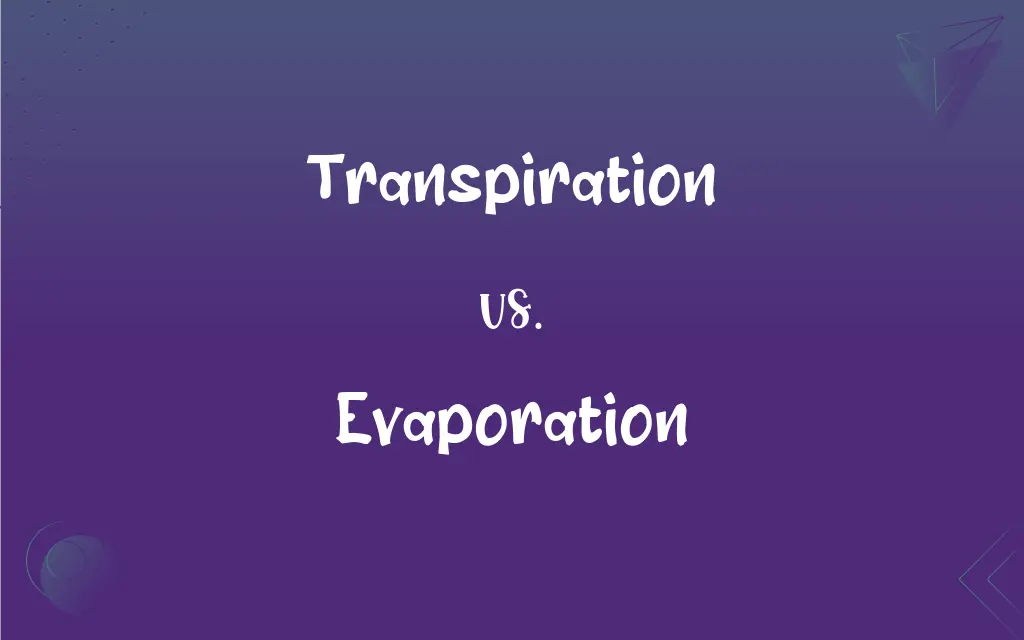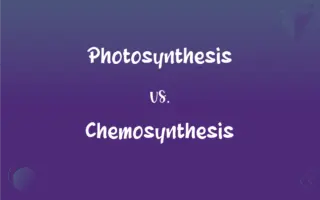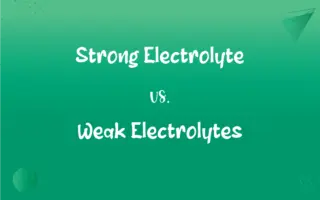Transpiration vs. Evaporation: What's the Difference?
Edited by Aimie Carlson || By Harlon Moss || Updated on October 16, 2023
Transpiration is water release from plants, while evaporation is water turning into vapor from all sources, like soil or bodies of water.

Key Differences
Transpiration involves the movement of water through a plant, culminating in water vapor release from aerial parts, mainly leaves. Evaporation, in contrast, is a broader process where water changes into vapor, occurring over any water body or moist surface, not just within living organisms.
Transpiration is an essential process for plants, as it contributes to the flow of nutrients and water from roots to shoots, driven by the loss of water vapor through stomata. Evaporation is a fundamental part of the water cycle, contributing to cloud formation and precipitation; it doesn't involve any biological process.
Transpiration rates are influenced by several environmental factors including light, humidity, temperature, and wind speed. Evaporation rates, on the other hand, depend on similar factors but occur over bodies of water, land, and other wet surfaces, including those affected by precipitation and condensation.
Transpiration, while often unseen, is critical for plant life, facilitating nutrient transport and keeping plants cool. Evaporation, though, plays a global role in maintaining the earth's water balance and temperature regulation, extending far beyond the reach of individual organisms.
Transpiration and evaporation, while similar in that they both involve the release of water into the atmosphere, differ fundamentally in scope and function. The former is a physiological process inherent to plants, whereas the latter is a physical process indispensable to the global water cycle.
ADVERTISEMENT
Comparison Chart
Definition
Biological process in plants.
Physical process over any wet surface.
Occurrence
Occurs in plants.
Occurs on any open water surface or wet area.
Function
Nutrient transport, cooling in plants.
Part of the water cycle, temperature regulation.
Factors Influencing
Light, humidity, temperature, wind, etc.
Heat, air movement, humidity, surface area, etc.
Role in Water Cycle
Minor direct role, major indirect impact.
Major direct role in water cycling.
ADVERTISEMENT
Transpiration and Evaporation Definitions
Transpiration
Transpiration is primarily controlled through tiny openings on leaves called stomata.
Stomatal movements are critical in regulating transpiration rates.
Evaporation
It's a fundamental part of the water cycle, responsible for the formation of clouds and precipitation.
The water cycle relies on evaporation to transport water from the earth's surface to the atmosphere.
Transpiration
Transpiration is the process by which moisture is carried through plants from roots to small pores on the underside of leaves, where it changes to vapor and is released to the atmosphere.
Transpiration in large forests can influence the local climate.
Evaporation
Evaporation is the process by which water changes from a liquid to a gas or vapor.
Evaporation from the lake increases during the hot summer months.
Transpiration
It's a vital mechanism in plants that aids in nutrient transport, maintaining water balance, and cooling.
Without transpiration, plants would overheat and fail to feed themselves.
Evaporation
It's a cooling process; as water evaporates, it absorbs heat and cools the surroundings.
Evaporative coolers rely on the principle of evaporation to lower air temperature.
Transpiration
Transpiration can be affected by several external factors, including temperature, humidity, wind, and light intensity.
On hot, dry days, plants may close their stomata to reduce transpiration and conserve water.
Evaporation
Evaporation occurs when the sun heats water in rivers, lakes, or the ocean, turning it into vapor that rises into the air.
Solar radiation drives evaporation, fueling the water cycle.
Transpiration
It's an integral part of the water cycle, although it represents only a small fraction of the total water movement.
Transpiration, along with evaporation, contributes to the atmospheric moisture.
Evaporation
Evaporation rates can be influenced by temperature, humidity, wind speed, and the surface area of the water.
Wind speed accelerates evaporation by dispersing the water molecules more rapidly.
Transpiration
The act or process of transpiring, especially through the stomata of plant tissue or the pores of the skin.
Evaporation
To convert or change into a vapor.
Transpiration
(botany) The loss of water by evaporation in terrestrial plants, especially through the stomata; accompanied by a corresponding uptake from the roots.
Evaporation
To draw off in the form of vapor.
FAQs
What is transpiration?
Transpiration is the process where plants absorb water through the roots and then give off water vapor through pores in their leaves.
Are transpiration and evaporation connected?
Yes, both are parts of the water cycle, contributing to atmospheric moisture.
Does transpiration only occur in plants?
Yes, transpiration specifically refers to the water movement through plants.
What role does heat play in evaporation?
Heat provides the energy necessary for water molecules to break free and become vapor.
Can evaporation happen anywhere?
Yes, evaporation can occur over any body of water or wet surface, given the right conditions.
Is transpiration visible to the naked eye?
Generally, no. Transpiration occurs on a microscopic level through the stomata on plant leaves.
How does evaporation affect the climate?
By influencing the water cycle, evaporation plays a crucial role in weather patterns and climate.
Does evaporation always lead to precipitation?
Not always directly, but it contributes to cloud formation, which can result in precipitation.
Does evaporation occur only during the day?
No, it can happen at any time, but it's generally faster during the day due to higher temperatures and sunlight.
Is evaporation a slow or fast process?
It varies depending on conditions, but generally, it's a gradual process.
What factors influence evaporation rates?
Temperature, air movement, humidity, and surface area all affect how quickly evaporation occurs.
How does evaporation occur?
Evaporation happens when liquid water gains enough energy to escape into the air as water vapor.
Why is transpiration important for plants?
It helps transport nutrients from the soil, maintains plant temperature, and contributes to water movement in the ecosystem.
How do plants control transpiration?
Plants regulate it mainly through the opening and closing of stomata, influenced by environmental conditions.
Can human activities affect evaporation?
Yes, activities that change land use patterns or water availability can impact evaporation rates.
How is transpiration measured?
Scientists often use tools like potometers or calculate it indirectly through changes in humidity or temperature.
What would happen if transpiration stopped?
Plants would overheat, nutrient transport would be hindered, and ecosystems' water cycles would be disrupted.
Do all plants transpire at the same rate?
No, transpiration rates vary based on plant type, environmental conditions, and water availability.
Is transpiration a passive or active process in plants?
It's both; water movement is passive, but stomatal control is an active process regulated by the plant.
Can environmental factors affect transpiration?
Absolutely, factors like light intensity, temperature, and humidity can significantly impact transpiration rates.
About Author
Written by
Harlon MossHarlon is a seasoned quality moderator and accomplished content writer for Difference Wiki. An alumnus of the prestigious University of California, he earned his degree in Computer Science. Leveraging his academic background, Harlon brings a meticulous and informed perspective to his work, ensuring content accuracy and excellence.
Edited by
Aimie CarlsonAimie Carlson, holding a master's degree in English literature, is a fervent English language enthusiast. She lends her writing talents to Difference Wiki, a prominent website that specializes in comparisons, offering readers insightful analyses that both captivate and inform.
































































